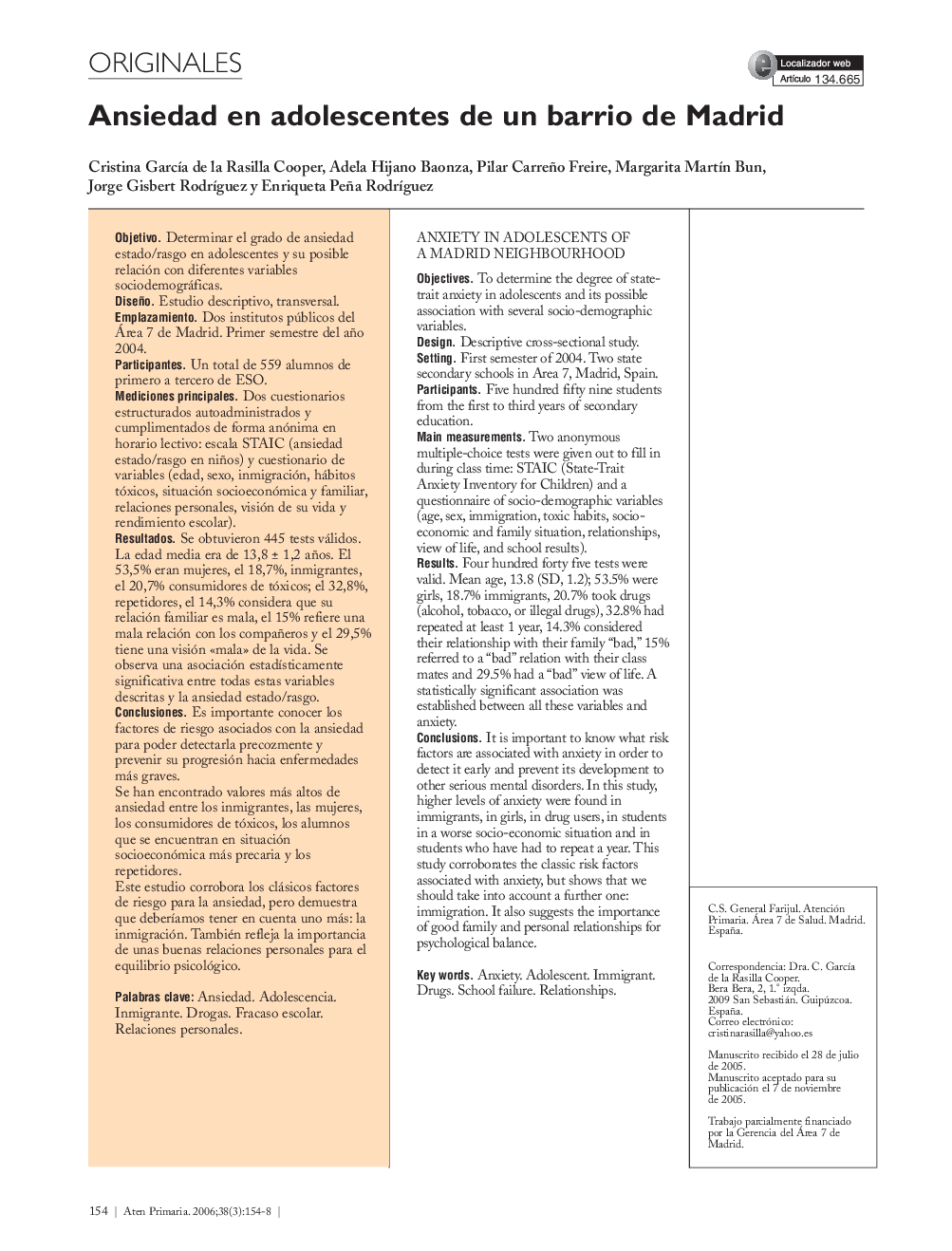| کد مقاله | کد نشریه | سال انتشار | مقاله انگلیسی | نسخه تمام متن |
|---|---|---|---|---|
| 3459175 | 1231070 | 2006 | 5 صفحه PDF | دانلود رایگان |

ObjetivoDeterminar el grado de ansiedad estado/rasgo en adolescentes y su posible relación con diferentes variables sociodemográficas.DiseñoEstudio descriptivo, transversal.EmplazamientoDos institutos públicos del Área 7 de Madrid. Primer semestre del año 2004.ParticipantesUn total de 559 alumnos de primero a tercero de ESO.Mediciones principalesDos cuestionarios estructurados autoadministrados y cumplimentados de forma anónima en horario lectivo: escala STAIC (ansiedad estado/rasgo en niños) y cuestionario de variables (edad, sexo, inmigración, hábitos tóxicos, situación socioeconómica y familiar, relaciones personales, visión de su vida y rendimiento escolar).ResultadosSe obtuvieron 445 tests válidos. La edad media era de 13,8 ± 1,2 años. El 53,5% eran mujeres, el 18,7%, inmigrantes, el 20,7% consumidores de tóxicos; el 32,8%, repetidores, el 14,3% considera que su relación familiar es mala, el 15% refiere una mala relación con los compañeros y el 29,5% tiene una visión «mala» de la vida. Se observa una asociación estadísticamente significativa entre todas estas variables descritas y la ansiedad estado/rasgo.ConclusionesEs importante conocer los factores de riesgo asociados con la ansiedad para poder detectarla precozmente y prevenir su progresión hacia enfermedades más graves.Se han encontrado valores más altos de ansiedad entre los inmigrantes, las mujeres, los consumidores de tóxicos, los alumnos que se encuentran en situación socioeconómica más precaria y los repetidores.Este estudio corrobora los clásicos factores de riesgo para la ansiedad, pero demuestra que deberíamos tener en cuenta uno más: la inmigración. También refleja la importancia de unas buenas relaciones personales para el equilibrio psicológico.
ObjectivesTo determine the degree of statetrait anxiety in adolescents and its possible association with several socio-demographic variables.DesignDescriptive cross-sectional study.SettingFirst semester of 2004.Two state secondary schools in Area 7, Madrid, Spain.ParticipantsFive hundred fifty nine students from the first to third years of secondary education.Main measurementsTwo anonymous multiple-choice tests were given out to fill in during class time: STAIC (State-Trait Anxiety Inventory for Children) and a questionnaire of socio-demographic variables (age, sex, immigration, toxic habits, socioeconomic and family situation, relationships, view of life, and school results).ResultsFour hundred forty five tests were valid. Mean age, 13.8 (SD, 1.2); 53.5% were girls, 18.7% immigrants, 20.7% took drugs (alcohol, tobacco, or illegal drugs), 32.8% had repeated at least 1 year, 14.3% considered their relationship with their family “bad,” 15% referred to a “bad” relation with their class mates and 29.5% had a “bad” view of life. A statistically significant association was established between all these variables and anxiety.ConclusionsIt is important to know what risk factors are associated with anxiety in order to detect it early and prevent its development to other serious mental disorders. In this study, higher levels of anxiety were found in immigrants, in girls, in drug users, in students in a worse socio-economic situation and in students who have had to repeat a year. This study corroborates the classic risk factors associated with anxiety, but shows that we should take into account a further one: immigration. It also suggests the importance of good family and personal relationships for psychological balance.
Journal: Atención Primaria - Volume 38, Issue 3, July 2006, Pages 154-158